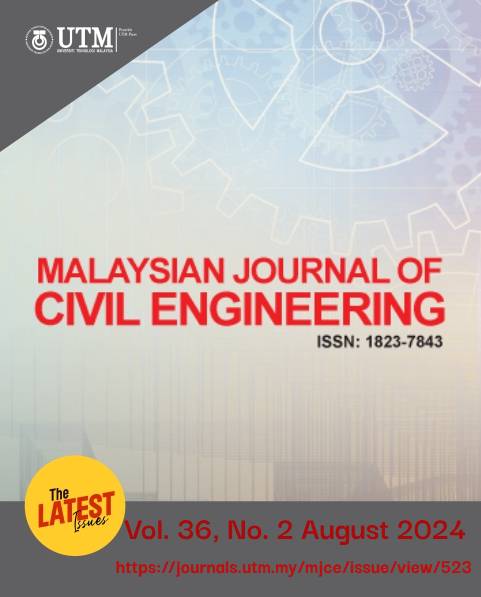EVALUATING THE STRUCTURAL EFFICACY OF ANGLE AND CHANNEL SHEAR CONNECTORS IN BRICK AGGREGATE CONCRETE AND STONE AGGREGATE CONCRETE AND COMPARISON
DOI:
https://doi.org/10.11113/mjce.v36.22331Keywords:
Push-out test, Composite structure, Failure mode, Energy absorption, Load-slip behaviorAbstract
Composite structure is becoming prominent for its economy, less time consumption, and higher stiffness-mass ratio. Composite action of the steel-concrete composite structure mainly depends on the connector's geometry and materials. Proper choice of shear connector could make steel beam and concrete slab cross-section minimal. This study carries out push-out tests to evaluate the structural efficiency of channel and angle shear connectors in brick aggregate concrete and stone aggregate concrete. It specifically looks at the failure mode, ductility, load-slip behavior, and energy absorption capacity. In brick aggregate concrete, results show that under monotonic loading, channel connectors have been found to have 15.27% more shear capacity & 28.38% more slip than angle connectors. Similarly, in stone aggregate concrete, channel connectors have been found to have 14% more shear capacity & 12.97% higher slip than angle connectors. On average, stone aggregate concrete has been found to have 34.84% higher shear capacity and 6.7% greater slip than brick aggregate concrete. Strain energy and plastic energy were found 78% and 17.6% less in brick aggregate specimens than those in stone aggregate specimens, respectively. Experimental results were slightly lower for both shear connectors than the empirical values.
References
B.L. Rajput, M.A. Hussain, N.N. Shaikh, J. Vadodaria, 2013. Time and Cost Comparison of Construction of RCC, Steel and Composite Structure Building. IUP Journal of Structural Engineering. 6(4): 49–59.
M.R. Salari, E. Spacone, P.B. Shing, D.M. Frangopol, 1998. Nonlinear Analysis of Composite Beams with Deformable Shear Connectors, Journal of Structural Engineering. 124: 1148–1158. https://doi.org/10.1061/(ASCE)0733-9445(1998)124:10(1148).
D. Arévalo, L. Hernández, C. Gómez, G. Velasteguí, E. Guaminga, R. Baquero, R. Dibujés, 2021. Structural performance of steel angle shear connectors with different orientation, Case Studies in Construction Materials. 14: e00523. https://doi.org/10.1016/J.CSCM.2021.E00523.
I.M. Viest, C.P. Siess, J.H. Appleton, N.M. Newmark, 1951. Full-scale tests of channel shear connectors and composite t-beams, Studies of Slab and Beam Highway Bridges, Part IV. University of Illinois at Urbana Champaign, University of Illinois Engineering Experiment Station, Bulletin Series No. 405.
R.S. Narahari, 1970. Composite Construction - Tests On Small-Scale Shear Connectors, Inst Engrs Civil Eng Trans /Australia/. 12(1): 106–115.
[6] B.J. Daniels, M. Crisinel, 1993. Composite Slab Behavior and Strength Analysis. Part I: Calculation Procedure, Journal of Structural Engineering. 119: 16–35. https://doi.org/10.1061/(ASCE)0733-9445(1993)119:1(16).
Lungershausen, 1988. H.: Zur Schubtragfähigkeit von Kopfbolzendübeln, Mitteilung Nr. 88-7, Institut für konstruktiven Ingenieurbau, Ruhr-Universität Bochum, Dissertation.
N. Europeenne, 2004. EUROPEAN STANDARD Eurocode 4: Design of composite steel and concrete structures-Part 1-1: General rules and rules for buildings.
A. Shariati, N.H. Ramli Sulong, M. Suhatril, M. Shariati, 2012. Investigation of channel shear connectors for composite concrete and steel T-beam, International Journal of the Physical Sciences. 7(11): 1828–1831. https://doi.org/10.5897/IJPS11.1604.
M. Shariati, N.H. Ramli Sulong, A. Shariati, M.A. Khanouki, 2016. Behavior of V-shaped angle shear connectors: experimental and parametric study, Materials and Structures. 49: 3909–3926. https://doi.org/10.1617/S11527-015-0762-8.
M. Shariati, N.H. Ramli Sulong, H. Sinaei, M.M. Arabnejad.Kh, P. Shafigh, 2011. Behavior of Channel Shear Connectors in Normal and Light Weight Aggregate Concrete (Experimental and Analytical Study), Advanced Materials Research. 168–170: 2303–2307. https://doi.org/10.4028/WWW.SCIENTIFIC.NET/AMR.168-170.2303.
R.T. Pardeshi, Y.D. Patil, 2021. Review Of Various Shear Connectors In Composite Structures, Advanced Steel Construction. 17(4): 394–402. https://doi.org/10.18057/IJASC.2021.17.4.8.
A. Shariati, N. H. Ramli Sulong, M. Suhatril, M. Shariati, 2012. Various types of shear connectors in composite structures: A review, International Journal of the Physical Sciences. 7(22): 2876–2890. https://doi.org/10.5897/ijpsx11.004.
[14] J. da C. Vianna, L.F. Costa-Neves, P.C.G. da S. Vellasco, S.A.L. de Andrade, 2008. Structural behaviour of T-Perfobond shear connectors in composite girders: An experimental approach, Engineering Structures. 30(9): 2381–2391. https://doi.org/10.1016/j.engstruct.2008.01.015.
[15] Z.S. Wang, H.Q. Qin, Y. Yang, Y.H. Liu, H.C. Guo, J.B. Tian, 2022. Study of bond-slip performance and ultimate bearing capacity calculation under static and reciprocating action of folded perfobond shear keys, Case Studies in Construction Materials. 17: e01347. https://doi.org/10.1016/j.cscm.2022.e01347.
B. Lu, C. Zhai, S. Li, W. Wen, 2019. Predicting ultimate shear capacities of shear connectors under monotonic and cyclic loadings, Thin-Walled Structures. 141: 47–61. https://doi.org/10.1016/j.tws.2019.04.002.
A. ACI, 2009. 211.1-91 (Reapproved 2009) Standard practice for selecting proportions for normal, heavyweight, and mass concrete.
ANSI/AISC 360-10, 2010. Specification for Structural Steel Buildings. Approved by the AISC Committee on Specifications.
P. BS5950, 1990. 3-1, Structural use of steelwork in building: Code of practice for design of simple and continuous composite beams, London: British Standards Institution.
ANSI/AISC 360-05, 2005. Specification for Structural Steel Buildings. Approved by the AISC Committee on Specifications and issued by the AISC Board of Directors.
National building code of Canada, 2005. Issued by the Canadian Commission on Building and Fire Codes., Institute for Research in Construction (Canada), 12th Edition.
O. Kiyomiya, H. Yokota, 1986. Strength of shear connector by shape steel in composite member with steel and concrete, in: Proc. of Symposium on Research and Application of Composite Constructions, Japan Society of Civil Engineers. 113–118.
















